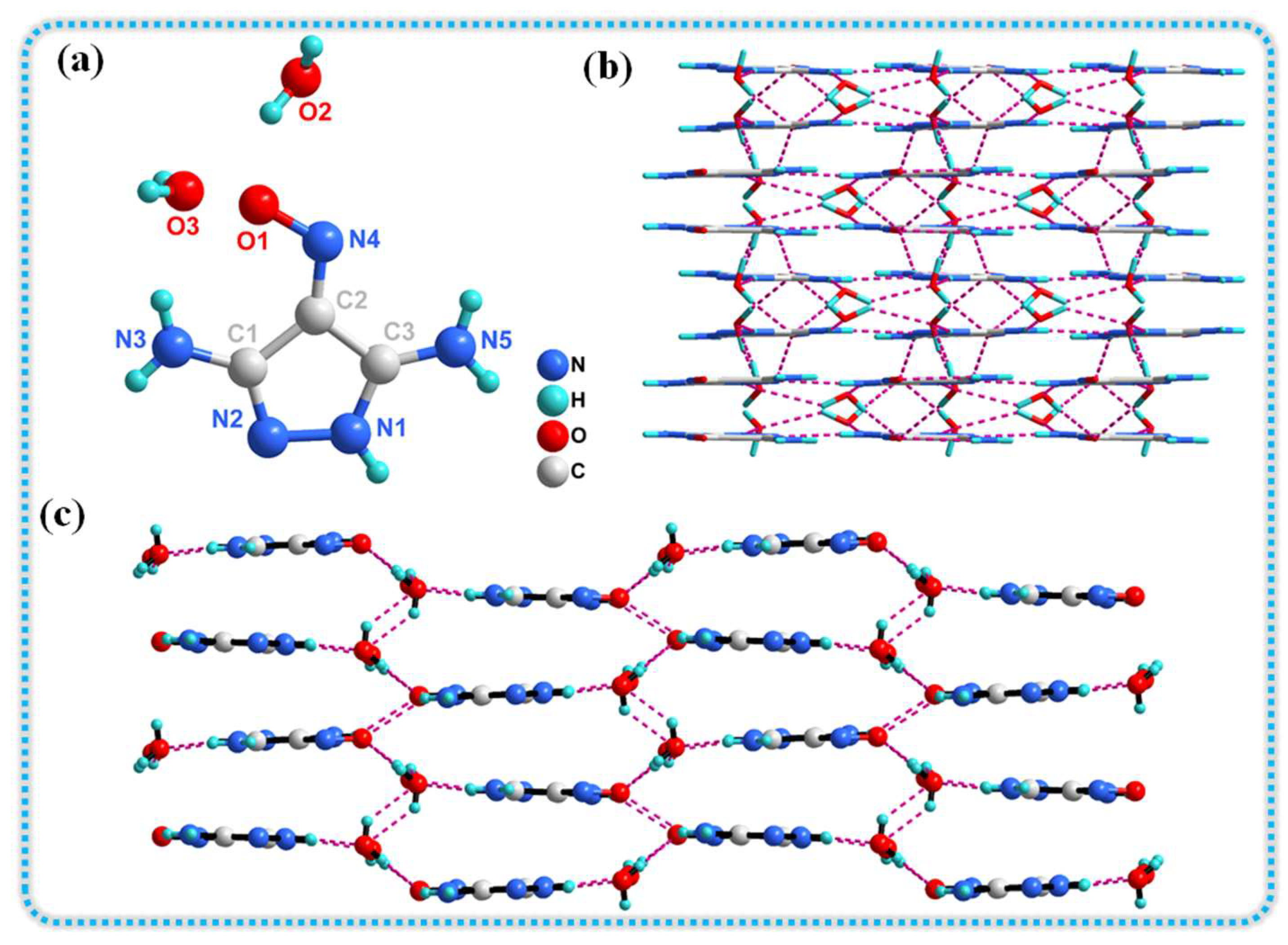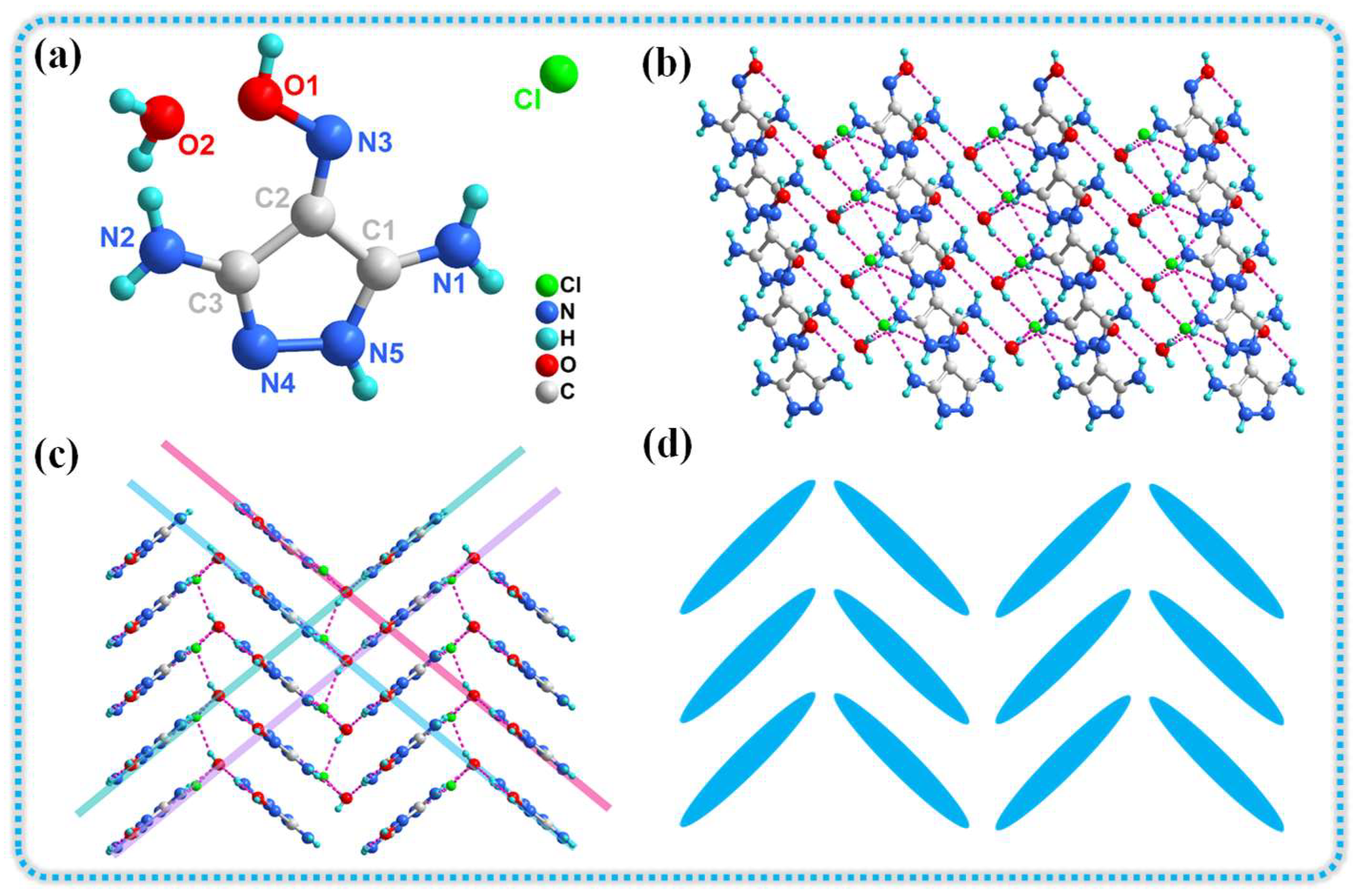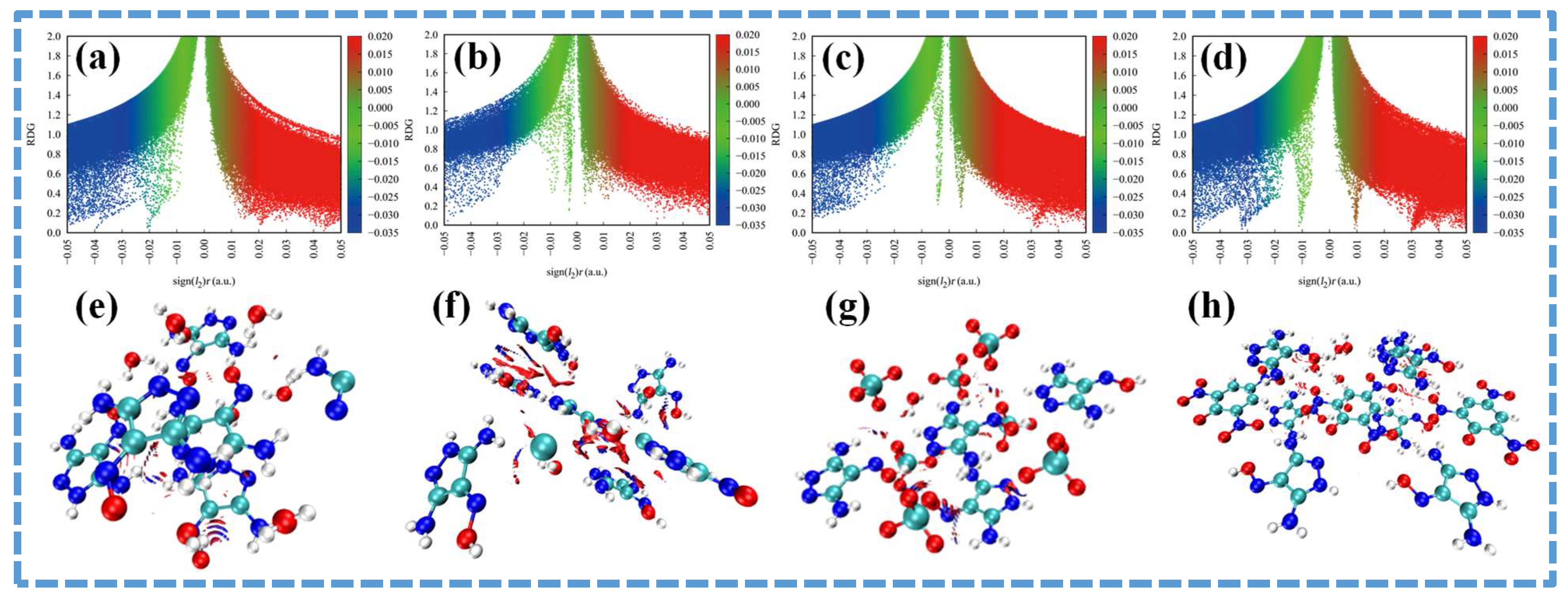Synthesis, Crystal Structure, and Characterization of Energetic Salts Based on 3,5-Diamino-4H-Pyrazol-4-One Oxime
Abstract
:1. Introduction
2. Results
2.1. X-ray Structure Analysis
2.2. Intermolecular Interactions
2.3. Energetic Performance and Safety
3. Materials and Methods
3.1. 3,5-diamino-4H-pyrazol-4-one Oxime (DAPO)
3.2. 3,5-diamino-4H-pyrazol-4-one Oxime Hydrochloride Salt (DAPOC)
3.3. 3,5-diamino-4H-pyrazol-4-one Oxime Perchlorate Salt (DAPOP)
3.4. 3,5-diamino-4H-pyrazol-4-one Oxime Picrate (DAPOT)
4. Conclusions
Supplementary Materials
Author Contributions
Funding
Institutional Review Board Statement
Informed Consent Statement
Data Availability Statement
Conflicts of Interest
Sample Availability
References
- Hermann, T.S.; Karaghiosoff, K.; Klapöetke, T.M.; Stierstorfer, J. Synthesis and characterization of 2,2 ‘-dinitramino-5,5 ‘-bi(1-oxa-3,4-diazole) and derivatives as economic and highly dense energetic materials. Chem. Eur. J. 2017, 23, 12087–12091. [Google Scholar] [CrossRef] [PubMed] [Green Version]
- Tang, Y.; Imer, G.H.; Parrish, D.A.; Shreeve, J.M. Energetic and fluorescent azole-fused 4-amino-1,2,3-triazine-3-N-oxides. ACS Appl. Energy Mater. 2019, 2, 8871–8877. [Google Scholar] [CrossRef]
- Tang, Y.; He, C.; Mitchell, L.A.; Parrish, D.A.; Shreeve, J.M. Energetic compounds consisting of 1,2,5- and 1,3,4-oxadiazole rings. J. Mater. Chem. A 2015, 3, 23143–23148. [Google Scholar] [CrossRef]
- Zhang, S.; Cheng, G.; Yang, H. Studies on the synthesis and properties of nitramino compounds based on tetrazine backbones. Dalton Trans. 2020, 49, 5590–5596. [Google Scholar] [CrossRef]
- Hu, L.; Staples, R.J.; Shreeve, J.M. Energetic compounds based on a new fused triazolo[4,5-d]pyridazine ring: Nitroimino lights up energetic performance. Chem. Eng. J. 2021, 129839. [Google Scholar] [CrossRef]
- Ding, L.; Wang, P.; Lin, Q.; Li, D.; Xu, Y.; Lu, M. Synthesis, characterization and properties of amphoteric heat-resistant explosive materials: Fused [1,2,5]oxadiazolo [3’,4’:5,6]pyrido[4,3-d][1,2,3]triazines. Chem. Eng. J. 2022, 432, 134293. [Google Scholar] [CrossRef]
- Zhang, M.-X.; Pagoria, P.F.; Imler, G.H.; Parrish, D. Trimerization of 4-amino-3,5-dinitropyrazole: Formation, preparation, and characterization of 4-diazo-3,5-bis(4-amino-3,5-dinitropyrazol-1-yl) pyrazole (LLM-226). J. Heterocycl. Chem. 2019, 56, 781–787. [Google Scholar] [CrossRef]
- Yu, Q.; Yang, H.; Imler, G.H.; Parrish, D.A.; Cheng, G.; Shreeve, J.M. Derivatives of 3,6-bis(3-aminofurazan-4-ylamino)-1,2,4,5-tetrazine: Excellent energetic properties with lower sensitivities. ACS Appl. Energy Mater. 2020, 12, 31522–31531. [Google Scholar] [CrossRef]
- Xu, Y.; Tian, L.; Li, D.; Wang, P.; Lu, M. A series of energetic cyclo-pentazolate salts: Rapid synthesis, characterization, and promising performance. J. Mater. Chem. A 2019, 7, 12468–12479. [Google Scholar] [CrossRef]
- Chavez, D.E.; Bottaro, J.C.; Petrie, M.; Parrish, D.A. Synthesis and thermal behavior of a fused, tricyclic 1,2,3,4-tetrazine ring system. Angew. Chem. Int. Ed. 2015, 54, 12973–12975. [Google Scholar] [CrossRef]
- Lai, Y.; Liu, Y.; Huang, W.; Zeng, Z.; Yang, H.; Tang, Y. Synthesis and characterization of pyrazole- and imidazole-derived energetic compounds featuring ortho azido/nitro groups. FirePhysChem 2022, 2, 140–146. [Google Scholar] [CrossRef]
- Yang, J.; Yin, X.; Wu, L.; Wu, J.; Zhang, J.; Gozin, M. Alkaline and earth alkaline energetic materials based on a versatile and multifunctional 1-aminotetrazol-5-one ligand. Inorg. Chem. 2018, 57, 15105–15111. [Google Scholar] [CrossRef] [PubMed]
- Dippold, A.A.; Izsák, D.; Klapötke, T.M.; Pflüger, C. Combining the advantages of tetrazoles and 1,2,3-triazoles: 4,5-bis(tetrazol-5-yl)-1,2,3-triazole, 4,5-bis(1-hydroxytetrazol-5-yl)1,2,3-triazole, and their energetic derivatives. Chem. Eur.J. 2016, 22, 1768–1778. [Google Scholar] [CrossRef] [PubMed]
- Domasevitch, K.V.; Gospodinov, I.; Krautscheid, H.; Klapötke, T.M.; Stierstorfer, J. Facile and selective polynitrations at the 4-pyrazolyl dual backbone: Straightforward access to a series of high-density energetic materials. New, J. Chem. 2019, 43, 1305–1312. [Google Scholar] [CrossRef]
- Tang, Y.; He, C.; Imler, G.H.; Parrish, D.A.; Shreeve, J.M. Aminonitro groups surrounding a fused pyrazolotriazine ring: A superior thermally stable and insensitive energetic material. ACS Appl. Energy Mater. 2019, 2, 2263–2267. [Google Scholar] [CrossRef]
- Kumar, D.; Imler, G.H.; Parrish, D.A.; Shreeve, J.M. 3,4,5-Trinitro-1-(nitromethyl)-1H-pyrazole (TNNMP): A perchlorate free high energy density oxidizer with high thermal stability. J. Mater. Chem. A 2017, 5, 10437–10441. [Google Scholar] [CrossRef]
- Zhang, Z.-B.; Xu, C.-X.; Yin, X.; Zhang, J.-G. Hydrazine 5,5’-bitetrazole-1,11’-diolate: A promising high density energetic salt with good propertiest. Dalton Trans. 2016, 45, 19045–19052. [Google Scholar] [CrossRef] [PubMed]
- Zhao, B.; Li, X.; Wang, P.; Ding, Y.; Zhou, Z. A novel facile transformation to 1,2-bis(3-nitro-1-(1H-tetrazol-5-yl)-1H-1,2,4-triazol-5-yl)hydrazine salts. New, J. Chem. 2018, 42, 14087–14090. [Google Scholar] [CrossRef]
- Zhang, M.; Gao, H.; Li, C.; Fu, W.; Tang, L.; Zhou, Z. Towards improved explosives with a high performance: N-(3,5-dinitro-1H-pyrazol-4-yl)-1H-tetrazol-5-amine and its salts. J. Mater. Chem. A 2017, 5, 1769–1777. [Google Scholar] [CrossRef]
- Yin, P.; Parrish, D.A.; Shreeve, J.M. Energetic multifunctionalized nitraminopyrazoles and their ionic derivatives: Ternary hydrogen-bond induced high energy density materials. J. Am. Chem. Soc. 2015, 137, 4778–4786. [Google Scholar] [CrossRef]
- Li, C.; Zhang, M.; Chen, Q.; Li, Y.; Gao, H.; Fu, W.; Zhou, Z. 1-(3,5-Dinitro-1H-pyrazol-4-yl)-3-nitro-1H-1,2,4-triazol-5-amine (HCPT) and its energetic salts: Highly thermally stable energetic materials with high-performance. Dalton Trans. 2016, 45, 17956–17965. [Google Scholar] [CrossRef] [PubMed]
- Zhang, L.; Dong, W.-S.; Lu, Z.-J.; Wang, T.-W.; Zhang, C.; Zhou, Z.-N.; Zhang, J.-G. Synthesis and characterization of thermally stable energetic complexes with 3,5-diaminopyrazolone-4-oxime as a nitrogen-rich ligand. CrystEngComm 2022, 24, 5519–5526. [Google Scholar] [CrossRef]
- Arulsamy, N.; Bohle, D.S. Nucleophilic addition of hydroxylamine, methoxylamine, and hydrazine to malononitrileoxime. J. Org. Chem. 2000, 1139–1143. [Google Scholar] [CrossRef] [PubMed]
- He, C.; Yin, P.; Mitchell, L.A.; Parrish, D.A.; Shreeve, J.M. Energetic aminated-azole assemblies from intramolecular and intermolecular N-H hydrogen bonds. Chem. Commun. 2016, 52, 8123–8126. [Google Scholar] [CrossRef]
- Lu, T.; Chen, F. Quantitative analysis of molecular surface based on improved marching tetrahedra algorithm. J. Mol. Graph. Model. 2012, 38, 314–323. [Google Scholar] [CrossRef] [PubMed]
- Lu, T.; Chen, F. Multiwfn: A multifunctional wavefunction analyzer. J. Comput. Chem. 2012, 33, 580–592. [Google Scholar] [CrossRef]
- Frisch, M.J.; Trucks, G.W.; Schlegel, H.B.; Scuseria, G.E.; Robb, M.A.; Cheeseman, J.R.; Montgomery, J.A.; Vreven, T.; Kudin, K.N.; Burant, J.C.; et al. Gaussian 09, Revision, A.02; Gaussian, Inc.: Wallingford, CT, USA, 2009; Available online: https://gaussian.com/g09citation/ (accessed on 25 December 2022).
- Wu, B.; Du, H.; Hu, P.; Gao, Z.; Liu, R.; Pei, C. Novel high-energy ionic molecules deriving from new monovalent and divalent 4-oxyl-3,5-dinitropyrazolate moieties. J. Energ. Mater. 2020, 39, 10–22. [Google Scholar] [CrossRef]








| Comp. | DAPO | DAPOC | DAPOP | DAPOT |
|---|---|---|---|---|
| Empiricalformula | C3H9N5O3 | C6H16Cl2N10O4 | C3H9N5O6Cl | C9H16N8O11 |
| Formula weight | 163.15 | 363.19 | 246.6 | 412.275 |
| Temperature/K | 293 | 163.15 | 293 | 293 |
| Crystal system | monoclinic | monoclinic | triclinic | orthorhombic |
| Space group | P21/c | Cc | P-1 | Pbcm |
| a/Å | 6.2790(6) | 6.5867(13) | 6.5946(6) | 9.0548(9) |
| b/Å | 6.6441(7) | 8.1018(16) | 12.6627(11) | 28.049(3) |
| c/Å | 17.6502(15) | 14.967(3) | 13.3405(12) | 6.3390(6) |
| α/° | 90 | 90 | 111.971(5) | 90 |
| β/° | 93.914(2) | 102.66(3) | 103.828(4) | 90 |
| γ/° | 90 | 90 | 99.551(3) | 90 |
| Volume/Å3 | 734.62(12) | 779.3(3) | 961.98(15) | 1609.9(3) |
| Z | 4 | 2 | 4 | 4 |
| ρcalcg/cm3 | 1.475 | 1.548 | 1.703 | 1.701 |
| μ/mm−1 | 0.128 | 0.452 | 0.42 | 0.156 |
| F(000) | 344 | 376 | 508 | 856.8 |
| Crystal size/mm3 | 0.4 × 0.21 × 0.13 | 0.15 × 0.13 × 0.11 | 0.4 × 0.27 × 0.25 | 0.18 × 0.08 × 0.02 |
| Radiation | MoKα (λ = 0.71073) | MoKα (λ = 0.71073) | MoKα (λ = 0.71073) | MoKα (λ = 0.71073) |
| 2θ range for data collection/° | 4.62 to 50.04 | 5.58 to 54.934 | 3.78 to 50.04 | 5.36 to 50.04 |
| Index ranges | −7 ≤ h ≤ 7, −7 ≤ k ≤ 7, −20 ≤ l ≤ 16 | −8 ≤ h ≤ 8, −9 ≤ k ≤ 10, −10 ≤ l ≤ 19 | −7 ≤ h ≤ 7, −15 ≤ k ≤ 14, −15 ≤ l ≤ 13 | −10 ≤ h ≤ 10, −25 ≤ k ≤ 33, −6 ≤ l ≤ 7 |
| Reflections collected | 3512 | 2137 | 4818 | 1549 |
| Independent reflections | 1295 [Rint = 0.0952, Rsigma = 0.0710] | 1054 [Rint = 0.0285, Rsigma = 0.0260] | 3313 [Rint = 0.0657, Rsigma = 0.0661] | 1549 [Rint = 0.0000, Rsigma = 0.0730] |
| Data/restraints/parameters | 1295/0/100 | 1054/2/100 | 3313/0/275 | 1549/0/169 |
| F2 | 1.054 | 1.092 | 1.13 | 1.083 |
| Final R indexes [I ≥ 2σ (I)] | R1 = 0.0717, wR2 = 0.2029 | R1 = 0.0272, wR2 = 0.0668 | R1 = 0.1055, wR2 = 0.2766 | R1 = 0.1050, wR2 = 0.2449 |
| Final R indexes | R1 = 0.1136, wR2 = 0.2372 | R1 = 0.0276, wR2 = 0.0674 | R1 = 0.1238, wR2 = 0.2907 | R1 = 0.1739, wR2 = 0.2867 |
| CCDC | 2160045 | 222315 | 222316 | 222317 |
| Comp. | ρ a [g·cm−3] | Td b [°C] | ΔHf c [kJ·mol−1] | D d [m·s−1] | P e [GPa] | IS f [J] | FS g [N] |
|---|---|---|---|---|---|---|---|
| DAPOP | 1.831 | 182.0 | 67.4 | 8249 | 30.0 | 24 | 224 |
| DAPOT | 1.819 | 225.0 | 292.8 | 7865 | 25.9 | 40 | 360 |
| DNPO·N2H4 h | 1.726 | 185.4 | 42.9 | 8718 | 30.2 | 20 | 324 |
| DNPO·TAG h | 1.730 | 212.9 | 19.2 | 9208 | 31.2 | 20 | 324 |
Disclaimer/Publisher’s Note: The statements, opinions and data contained in all publications are solely those of the individual author(s) and contributor(s) and not of MDPI and/or the editor(s). MDPI and/or the editor(s) disclaim responsibility for any injury to people or property resulting from any ideas, methods, instructions or products referred to in the content. |
© 2023 by the authors. Licensee MDPI, Basel, Switzerland. This article is an open access article distributed under the terms and conditions of the Creative Commons Attribution (CC BY) license (https://creativecommons.org/licenses/by/4.0/).
Share and Cite
Dong, W.-S.; Zhang, L.; Cao, W.-L.; Lu, Z.-J.; Tariq, Q.-u.-N.; Zhang, C.; Wu, X.-W.; Li, Z.-Y.; Zhang, J.-G. Synthesis, Crystal Structure, and Characterization of Energetic Salts Based on 3,5-Diamino-4H-Pyrazol-4-One Oxime. Molecules 2023, 28, 457. https://doi.org/10.3390/molecules28010457
Dong W-S, Zhang L, Cao W-L, Lu Z-J, Tariq Q-u-N, Zhang C, Wu X-W, Li Z-Y, Zhang J-G. Synthesis, Crystal Structure, and Characterization of Energetic Salts Based on 3,5-Diamino-4H-Pyrazol-4-One Oxime. Molecules. 2023; 28(1):457. https://doi.org/10.3390/molecules28010457
Chicago/Turabian StyleDong, Wen-Shuai, Lu Zhang, Wen-Li Cao, Zu-Jia Lu, Qamar-un-Nisa Tariq, Chao Zhang, Xiao-Wei Wu, Zong-You Li, and Jian-Guo Zhang. 2023. "Synthesis, Crystal Structure, and Characterization of Energetic Salts Based on 3,5-Diamino-4H-Pyrazol-4-One Oxime" Molecules 28, no. 1: 457. https://doi.org/10.3390/molecules28010457
APA StyleDong, W.-S., Zhang, L., Cao, W.-L., Lu, Z.-J., Tariq, Q.-u.-N., Zhang, C., Wu, X.-W., Li, Z.-Y., & Zhang, J.-G. (2023). Synthesis, Crystal Structure, and Characterization of Energetic Salts Based on 3,5-Diamino-4H-Pyrazol-4-One Oxime. Molecules, 28(1), 457. https://doi.org/10.3390/molecules28010457







